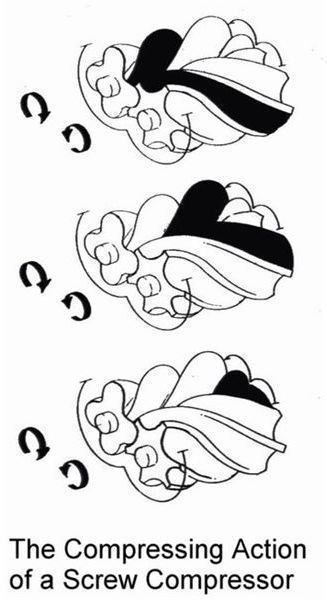I learned from That - Rotary Screw Compressor Overhauled, Explodes at First Start
A screw compressor is a positive displacement air pump, which has two screws meshing with each other, rotating at high speeds. One of the screws is attached to the prime mover shaft through a coupling. As the screws rotate inside the compressor casing, air is compressed between the casing and the screw pockets. Thus these are known as progressive piston air pumps.
Air Compressor Explosion
The incident happened on board a gas carrier, after a complete overhaul of a screw type control air compressor. The vessel had two control and two general service air compressors, which were of rotary screw type, operating at 7 bar pressure. One of the control air compressors were opened up for 3,000 hours routine maintenance. These were rotary screw compressors with a primary separator tank and screw-on oil filter. The 4th Engineer who was overhauling this compressor had successfully executed an overhaul of the same type of compressor on board the ship. As a part of the 3000 hours routine, the following components were removed for overhaul:
- Air Intake valve and its seals
- Air Delivery valve and its seals
- Lubricating oil filter
- Oil separator element filter
- Lubricating oil charge complete change
- Air filter renewal
- V-belt renewal
- Air and lubricating oil cooler external fins cleaning
All the routine work was done perfectly and the 4th Engineer had a last pending job of lubricating oil renewal and filter replacement. He had plans to complete the job on time and was working hard and fast to finish within the deadline. This was when he started to lose his concentration, working under his own self-pressure to complete the job. The focus was not on the assembling of compressor parts, but was on finishing the job within his self-prescribed deadline.
The Incident
The 4th Engineer drained the lube oil from the sump and cleaned it completely, after which he filled the sump with a new charge of oil. He then removed the lube oil filter which was a “Use and Throw” cartridge type. The old filter cartridge was dismantled and discarded, as the o-ring was left unseen on the filter casing. When he picked up the new filter, it had a new o-ring within it. He noticed both the new and old o-rings and misunderstood that the filter assembly had two o-rings. He assembled the lube oil filter with two o-rings and tightened it completely.
After completing the overhaul, he took the compressor on Local/Manual mode, to check the performance. When he started the compressor, there was a sudden spray of oil from the lube oil filter. Before he could attempt to stop the compressor, the complete charge of oil from the sump spilled over the engine room platform. He pressed the “Emergency Stop” after which the compressor stopped. The pressure accumulated within the sump was sufficient enough to spray out more oil. The complete platform was full of oil and the compressor oil sump was completely empty. There was huge smoke coming out of the compressor casing. The “All Engineer’s call alarm” was raised immediately and the incident was reported to senior engineers for investigation.
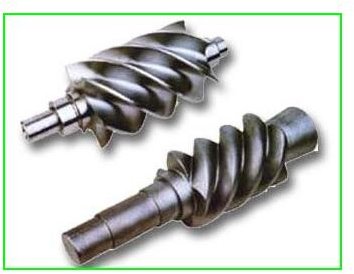
The lubricating oil filter assembled with two o-rings in place.
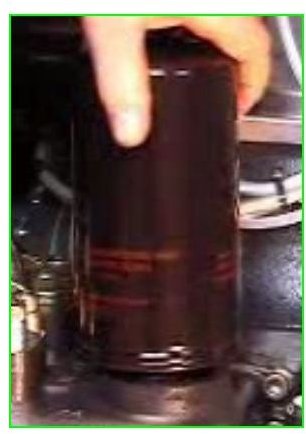
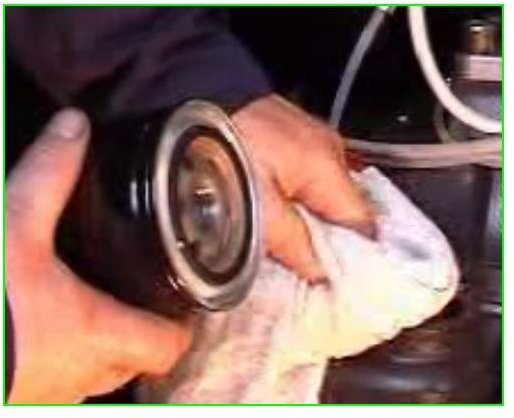
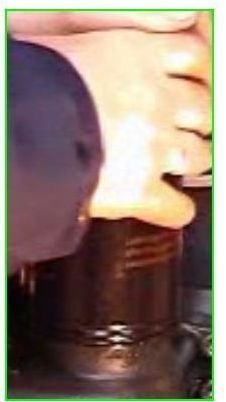
It is clearly written upon the filter cartridge that the filter has to be tightened 3/4th turn more after the o-ring touches the filter casing.
The Root Cause
The low lubricating oil pressure switch cock had been leaking and thus was shut off sometime in the past. This was neither notified to anyone nor specified in the hand-over reports. Thus low lubricating oil pressure did not activate a trip, causing the compressor to continue to run even without lubricating oil. Also the 4th Engineer was not concentrating on the filter assembly when dismantling it. He did not refer to the manufacturer’s manual when he was in doubt regarding the number of o-rings on the filter casing.
The drive ard driven screws got completely jammed and the bearings wiped off due to lack of lubricating oil when running at full speed. The filter cartridge was found damaged and the o-rings torn off. The entire screw set and bearing set had to be renewed.
The After Effects
The view of lubricating oil sump and level indicator stick inside the compressor casing. The picture clearly shows the method of adding oil to the sump with the help of the filling and vent plugs open.

The ship had no standby control air compressor. This was a very critical situation where the entire cargo system and the main engine control system depended on control air to function properly. The incident was reported to the superintendent of the vessel with the complete investigation report. There was no way to put back the compressor in use and thus a new air compressor was supplied to the vessel in order to avoid a more dangerous situation. The cost of the air compressor was some thousands of dollars which shoot up above the predicted budget. Thus a simple mistake of not noticing an o-ring incurred a heavy ransom. All other sister ships were sent circulars regarding the accident which made every ship check the operation of the low lubricating oil pressure switch. Also the senior engineers were made to conduct a tool box talk (TBT) before, during, and after the completion of the job.
Conclusion
From this incident, it is evident that the alertness of engineers who work onboard is of prime importance and there is no margin for errors. At last I would like to conclude this article admitting that the 4th engineer who overhauled the compressor was none other than “ME.”
Image Credits
The snaps of the images used in this article were taken during the overhaul of other compressors during my tenure on board.
